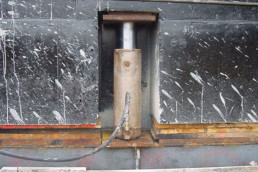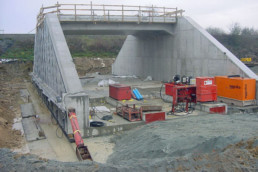Box Jacking
A previously constructed (tunnel) tube or bridge from concrete and/or steel is taken within a reasonable short amount of time from its pre-construction site to its final location using special hoisting jack techniques.
References
ANTWERPEN (Liefkenshoektunnel)
Principal: Infrabel
Main Contractor: THV Locobouw between CFE nv – CEI-De Meyer NV – Vinci SAS -Wayss&Freytag AG
Execution: December, 2009
In the Antwerp port, the left Scheldt bank is connected to the existing railway network on the right bank of the river Scheldt, named the Liefkenshoek railway connection. To that end, a roofing sheet of 620 tonnes must be moved over a length of 30 m. The roofing sheet has a length of 23 m, is 13 m wide and 0.75 m high.
FELUY
Principal: I.D.E.A.
Main Contractor: Eraerts, Dragages et Entreprises SA
Execution: November, 2003
For the creation of the industrial zone of Feluy, 2 passages had to be built under the railway lines of NMBS to connect the road Chaussée de la Résistance to Rue de Nivelles. The passage under the second bridge was excavated, 32 jacks were placed under the prefabricated frame bridge to lift them and place them on temporary tracks, eventually pushing them into the passage. The tubular bridge was displaced over a length of 33.5m and weighs 1,850 tonnes.
ZAVENTEM (Airport Gardens)
Principal: Airport Gardens NV
Main Contractor: TV Vanhout – Interbuild
Execution: 2000 – 2001
Since the access road to the airport along the A201 had to stay open at all times, it was opted to put a tunnel under this road using the ‘displacement technique’.
The five tunnel sections, each of which measured 12 m in width, 7 m in height, 22 m in length and weighed 1,750 tonnes, were prebuilt in a construction pit and subsequently displaced underneath a temporary bridge.






